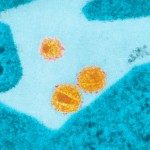Lien vers Pubmed [PMID] – 9300725
J. Immunol. 1997 Sep;159(6):3000-8
For efficient entry into target cells, certain T cell-tropic HIV-1 isolates require both CD4 and the coreceptor CXCR4. However, the molecular interactions among CD4, CXCR4, and the HIV-1 envelope glycoproteins are only now being elucidated. Here we show that the binding of soluble gp120 from one macrophage-tropic and four T cell-tropic viruses to a CD4+, but not to a CD4-, T cell line, decreased the binding of an mAb specific for CXCR4 to its epitope, implying an interaction among gp120, CD4, and CXCR4. To confirm such an interaction, we conducted double- and triple-color confocal laser scanning microscopy on CD4+/CXCR4+ cells and determined the extent of CD4 and CXCR4 colocalization by a semiquantitative analysis. In the absence of gp120, a low level of constitutive colocalization between CD4 and CXCR4 was observed. Treatment with T cell-tropic-derived gp120 and, to a lesser extent, macrophage-tropic-derived gp120, increased the colocalization of CD4 with CXCR4, and triple staining indicated that gp120 was associated with the CD4-CXCR4 complexes. Cocapping of the gp120-CD4-CXCR4 complexes at 37 degrees C resulted in the cointernalization of a proportion of the gp120-CXCR4 complexes into intracellular vesicles. These data demonstrate that the binding of gp120 to CD4+ T cells induces the formation of a trimolecular complex consisting of gp120, CD4, and the HIV-1 coreceptor molecule CXCR4.

